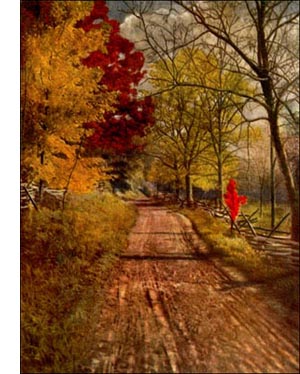Hercules Club Tree
 Hercules' Club (Aralia spinosa, Linn.)-A spreading, aromatic, spiny tree, with club-like branches, 25 to 35 feet high, or an unbranched shrubby cluster of shoots from underground stems, 6 to 15 feet high in one season. Bark dark brown, furrowed by wide, shallow cracks between rounded ridges. Wood light, brittle, pale brown, soft.
Hercules' Club (Aralia spinosa, Linn.)-A spreading, aromatic, spiny tree, with club-like branches, 25 to 35 feet high, or an unbranched shrubby cluster of shoots from underground stems, 6 to 15 feet high in one season. Bark dark brown, furrowed by wide, shallow cracks between rounded ridges. Wood light, brittle, pale brown, soft. Buds: terminal, large, blunt; lateral, flat, small, triangular. Leaves clustered near top of branch, 3 to 4 feet long, 1 to 2 1/2 feet wide, twice compound, on stout, spiny petioles; leaflets oval, pointed, with toothed margins; yellow in autumn.
Flowers white, minute, in many-flowered umbels, forming compound panicles often 3 to 4 feet high above the leaves in midsummer. fruits few, berry-like, juicy, purplish. Nutlets 5, hard, flattened. Preferred habitat, deep, moist soil near water courses.
Distribution, Pennsylvania to southern Missouri, south to Florida and Texas. Uses: Handsome and quick-growing ornamental tree. Berries and fleshy roots have medicinal properties, used in home remedies.
The Hercules' club certainly earns its name when an underground stem, stored with plant food, sends up its lusty shoots in spring. The ailanthus, in its most ambitious efforts, never threw up such tall, thick sprouts. Fifteen to twenty feet these unbranched shoots grow, and crown themselves with umbrellas of leaves, twice compound like those of the Kentucky coffee-tree, but much larger. In fact, no temperate zone tree has leaves of such dimensions, though the oval leaflets are moderate in size, and people are likely to mistake the strong, spiny petiole of this leaf for a branch.
These leaves deserve more than a passing comment. They come out with a rich, silky bronze sheen in spring, and turn to red and gold in autumn. They sway in the summer winds, giving the tree the look of a royal palm transplanted from the land of the orange and citron. I have seen a vacant lot overrun by these headstrong yearlings, and there is no such sight outside the tropics for unrestrained vegetable exuberance. It would be a hardy person who succeeded in getting a piece of land away from these outlaws, for the stems though soft and brittle inside, have a tough, horny covering, and spines which though but skin deep are formidable weapons of defence.
The Hercules' club is very late about its blooming, which makes it horticulturally more valuable. There are few trees and shrubs in flower to compete with this one when the cloud of minute white flowers settles above its crown of leaves. What they lack in size as individuals they make up in numbers. The flower cluster matches the leaves in its dimensions. The purplish berries make a fine showing in the fall and winter.
This tree strongly reminds us of the wild sarsaparilla and the spikenard of our woodland rambles; and for the best of reasons. They are all members of the ginseng family, and all have the most extravagant habits, though but one is arborescent. All have a well-earned reputation for medicinal properties. The little plant from which the family name comes is noted the world over. The Chinese reverence its "man-shaped" root, and pay fabulous prices for it, believing that it cures all human ills. Since collectors have almost exterminated our wild ginseng, it is profitably cultivated for export. If it but grew as do the roots of Aralia spinosa -but then, the price would shrink accordingly, and people would still have to work for a living!
The name, Hercules' club, is also applied to the prickly ash, Fagara clava-herculis, with which this tree may become confused. Comparison of descriptions of the two will enable one to distinguish them without difficulty.